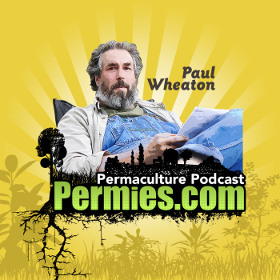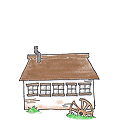 Listen Online
Listen Online  Download
Download  Get all of the podcasts in convenient, giant zip files
Get all of the podcasts in convenient, giant zip files  Subscribe on iTunes
Subscribe on iTunes Summary
Credit:
Summary
Credit: Julia Winter
When last we heard our fearless interviewees, Geoff was sounding like a robot due to internet wilding. They cut it off at that point, and have now gotten together to go through more questions:
"Should permaculturalists follow their national permaculture organization's rules, or do what
Bill Mollison says in his design manual." Geoff says, do what Bill advocates--that's what has made this a global movement. We will all support you--don't be bullied by some local person. There's no power in permaculture--it's not designed that way. If something doesn't fit for you, do what works. When you are doing the right thing, resources will gather around you (and many of those resources will be people).
"What do you feel is the role internships play in the advancement of permaculturists, after they've completed a PDC." Geoff says he puts a lot of emphasis on "master class" 10 week internships that the participants pay to participate. Right now he's got 23 interns at Zaytuna farm.
Geoff's interns are in a formalized pattern, where the interns do large animals for 10 days, small animals for 10 days, crop systems, food forest, compost/biochar/natural fertilizer, and utilities (water, waste, recycling). Each intern runs one of seven systems during their 10 days. There's a checklist for each person, every day and also short courses on other topics (urban, earthworks, etc) during the day. He sees this as fast tracking them into action. This 70 day program costs $7700. Zaytuna farm has been developing for 14 years, so it's really something to see. It's totally off grid and they make all their own food. (ed: well, except maybe for the wheat--see below)
If you go spend 10 weeks at Zaytuna farm, you will learn whether farming is really for you. Most people are really getting a clue by the 5th week. Maybe they are better at education, at other things than in-the-dirt farming. Coming out for an internship will make this clear. Paul thinks that $7700 is excellent value, given what you learn and what you could get connected with. Geoff says, yes, he is constantly hearing from people who need a good person to help them manage their land, and he is often sending his (good) students out to help others with their land. These days, when Geoff does a consultation, he brings all his interns along.
"What's your favorite storage/staple crop for cold climates?" Geoff says potatoes are probably his favorite, being something he's eaten his whole life. (Geoff is from England FYI.) Chestnuts are another. Hazelnuts, walnuts, monkey puzzle (ed: that has nuts?). He's rather go for a
root crop than a grain. Paul brings up sunchokes, Geoff says it's a novelty in his climate because it's actually hard to store in the constant warmth, and he brings up the "fartichoke" thing. In a cold climate, pumpkins, squashes store well in your house. Turnips, onions in cool dry storage. Paul lists the great properties of sunchokes, and adds in winter keeper apples. He agrees that grain is just a lot of work.
Geoff says that wheat is his wife's cultural
staple, and it sounds like although they grow some grains, they are buying some of that for their daily bread. He brings up low-tannic acorns as another possibility. There are people in Portugal with those. Ooh, ooh! If you have low tannin acorns, Paul would love some to plant on his land. Geoff expresses his jealousy of cold climates, because it's easier to store foods. He hasn't had much success with storage onions, he has to get by with much smaller perennial onions. (ed: grass is always greener, right?).
"If you had to choose two animals for a cold climate, what would they be?" Geoff says
dairy cow and chickens. Paul
roots for hogs. Geoff points out that eggs can be eaten by everyone, you don't need teeth to eat them. Geoff says he just doesn't feel normal without a working dog and a dairy cow.
"We live on the west coast of Ireland, close to the Atlantic, which keeps sending storms with salty spray at us. We're working on lots of hedges, but they are just not getting tall
enough!" Geoff says, you've just got to get out of that wind--can you build earth
berms? Can you build stone walls? You really need some hardy trees--don't limit yourself to local species. Hardy Norwegian spruce might be helpful. Make sure you provide special
shelter for the baby trees, help them get started. A berm can be great shelter for a line of trees, but if he doesn't have enough soil to build a berm, use rock to shield the trees. You're looking for trees with waxy leaves or needles--they will be able to harvest the wind.
"On
Wheaton laboratories, old maps show a creek, but the property is totally dry. You can find the creek further upstream, but it's gone underground, below alluvial soils. On terribly rainy days, there is still no water flow on the property. We have dug 16 foot deep holes in about a dozen spots, we've tried dowsing. (Paul describes dowsing with two metal rods.) In two spots, they went super big with the hole so they could go even deeper. They still didn't find water. Question for Geoff: what
should we do to secure a water source?" Geoff says does the water disappear in a big rounded flat spot? Paul says yes. Geoff asks "When you look at it from an aerial photograph, does it look like it could have been a dam, once? Is it really, really flat? Paul says, no, it's not terribly flat. Geoff recommends looking at it on Google Earth--could it have been an ancient beaver dam? Look around, are there other places that look like this? When you dug, did you go through layers and layers? Paul says, no, when we dug deep, we went through 16 feet of silt. When we went down 24 feet, we brought up wet round river rock. Geof says this sounds like an ancient beaver dam to him. In American topographical maps, they'll call beaver activity "swales." He thinks that beavers have covered the original creek bed with 24 feet of silt over ages. Geoff asks, can you get above that site? Paul says, no, that's really at the top of our property. The part with the running creek is not on my property. Paul thinks his pile of silt is erosion runoff from poorly managed forest further up the mountain. Geoff says this sounds like an ideal site for a really big dam (pond), like a one acre pond. When he hears about the draw with clay, he says Paul should put in a pond up where the clay is, and bring water in a swale over to the silt field. Geoff thinks it would be cool to come out with his film crew and do some filming (and then maybe he could do some filming in high desert, which so many people have been asking about).
"How much is compromised by using coniferous
wood in your hugelkultur beds versus the usual deciduous wood?" Geoff says well, coniferous trees will be more acidic. . . Paul wonders if the wood is alkaline, while the bark is acidic, on conifers. Geoff says if you've got fungus in your conifers, go ahead and use them. Geoff asks about various deciduous trees that might be around until Paul explains that where they are, it's pretty much all coniferous in terms of trees. Geoff asks about what's the latitude, what's the altitude, how far are you from an ocean--these things help you determine equivalent climates. When Geoff finds out that the land was logged as recently as 10 years ago, he goes Hmmmmmm, but then Paul explains it wasn't clearcut, they just went in and took all the big trees (in other words there are trees older than 10 years, just no really big trees). Geoff says "give it a try." Paul says he thinks conifer is acceptable, cottonwood is better, but hauling wood for miles is silly. Geoff points out that putting acidifying wood on alkaline soil really isn't such a bad thing. He brings up biochar, and it is agreed that biochar is most helpful in the tropics.
"I heard about a permaculture curriculum for homeschooling?" Geoff says this request came from participants in last year's
online PDC who were homeschooling and their kids loved the stuff. Geoff thinks educating kids is a great idea--he's got 5 grandchildren and a young daughter, and he'd love to get that going, but it's on the list, along with translating all of the videos for non English speakers. Paul says what you can do right now is take the online course and share it with your kids--Geoff says sure, that's already happened.
"I live in a well-watered region of Michigan. What do I do differently?" Geoff says you can work on concentrating the water (into ponds) and the land (?raised beds) to make more productive areas. It's still helpful to still put swales on hillsides to gather and infiltrate the water using trees (swales are for trees).
Aquaculture can be terrifically productive. Paul says if you have really good 6 foot tall hugelkulturs, aligned with the winds, the tops will be drier and that could be useful to dry the soil.
"What are you reading?" Geoff is reading Malcom Gladwells "What the Dog Saw," he likes all his stuff. He recently enjoyed "The Brain That Changes Itself," "The Song of the Dodo" and "When the Rivers Run Dry."
Paul ends with a comment from Jennifer Wadsworth, who took Geoff's online PDC course last year. "This is what makes Geoff's course so awesome. He recorded maybe 50 hours of Q&A sessions for us. You can tell how much he cares. He's showing that here, answering all of our questions here for free." (ed: paraphrased, like all my "quotes.")
A big thank you to Geoff for answering all of our questions, and here's hoping that he comes out to Montana sometime soon to walk the land at Wheaton Laboratories! (ed: who needs to go surfing in Hawaii when you can dig dams and swales in Montana in the late winter?)
Support the Empire
Help support the empire and get all of the podcasts in bundles
here
To support production of these podcasts, make a donation
here at Paul's Patreon page.


 7
7









 2
2








 2
2







 1
1






















